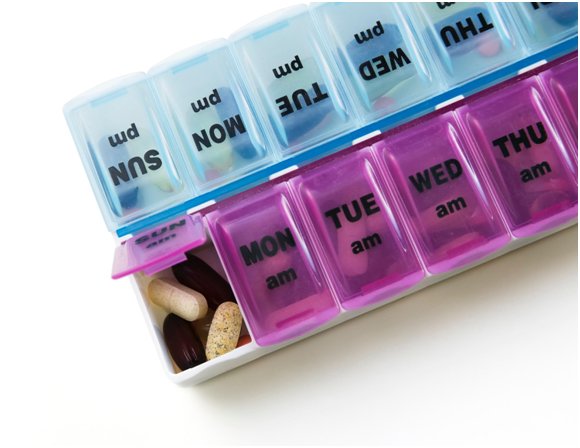Q: My doctor suggested I use a pillbox, but how do I get started? Which one is best?
Using a pillbox to help you take your medicine is a simple but very effective strategy for taking your medication safely. When the phone rings or your spouse asks you something, it’s all too easy to lose track of what you were you were doing. Did you already take that medicine? Hmm. Taking a guess can be risky, as an extra dose of pain or heart medicine can cause life-threatening side effects. If you’re using a pillbox, you can double-check yourself by flipping up the compartment’s lid to see if the pills are still there.
Using a pillbox gives you an early warning about needing another refill before taking your last dose of medicine, helping you avoid running entirely out of medicine, especially crucial with heart and blood thinner medicines.
Traveling with a pillbox instead of packing up all your pill bottles takes up less space, it avoids the disaster of you accidentally leaving ALL of your medicines behind somewhere along the way.
Which pillbox should you select? That depends on how many medications you take, how big your pills are, and how many times a day you need to take them. Do you only take one or two pills a day? Then you should be okay with a seven-day pillbox with one compartment for each day of the week. If you’re taking medicine in the morning and evening, choose a pillbox with two compartments for each day, often labeled AM and PM. There are also pill boxes with four compartments for each day of the week: AM, noon, PM, and bedtime. With larger pills like potassium, vitamins, or fish oil, you’ll want to make sure each compartment is large enough for all of the medicines.
It’s also a good idea to get two pillboxes, each a different color or design. A second one allows you to set up two weeks’ worth of pills at a time or take over one week’s pills on a trip.
Here’s How I Fill a Pillbox:
- Collect your supplies.
To fill your pillbox, collect your pill bottles and a current list of your medicines. I prefer my pillbox in front of me and pill bottles at my left.
- Fill each compartment in your pillbox from each bottle.
Starting from the top of your list, make sure you have a medicine bottle for each medication that belongs in your pillbox. Open the bottle, check to see which compartment it belongs in and how many go in there. For example, one capsule in the AM means putting one pill in all 7 of the AM compartments.
- I turn each bottle upside down after I have added it.
After I fill the last space, I put the lid back on, turn the bottle upside down and set it on the table to my right. Then I check the list for the next medicine, find that bottle, fill each compartment, and turn the bottle over when I have finished with it.
- Double-check each compartment.
After finishing with your last bottle, there’s one task left: a double check.
One of my patients missed putting her blood thinner medicine in her pillbox and went a whole week without it, and had a stroke. After years of filling other people’s pillboxes, you’d think I would be fast and never mess it up. But there’s often someone trying to catch my attention in the middle of it, and once I respond to someone asking me to take a phone call from a doctor or answer his or her question, I lose track of where I was. That’s why I turn the bottles upside down once I’m done with them and why I created a pillbox worksheet to double-check my work.
The pillbox worksheet I use has a spot for writing how many pills to put in each compartment PLUS a row at the bottom for the TOTAL number of pills that should be in each compartment once you’ve finished. You can do the double-check yourself or ask a family member or caregiver to help you. A FREE copy of my Pillbox Worksheet is available at https://themedicationinsider.com/products.
- Store out of reach of children.
One last thing: pillboxes are NOT child-resistant, so PLEASE move them out of reach of small children with inquiring fingers.


